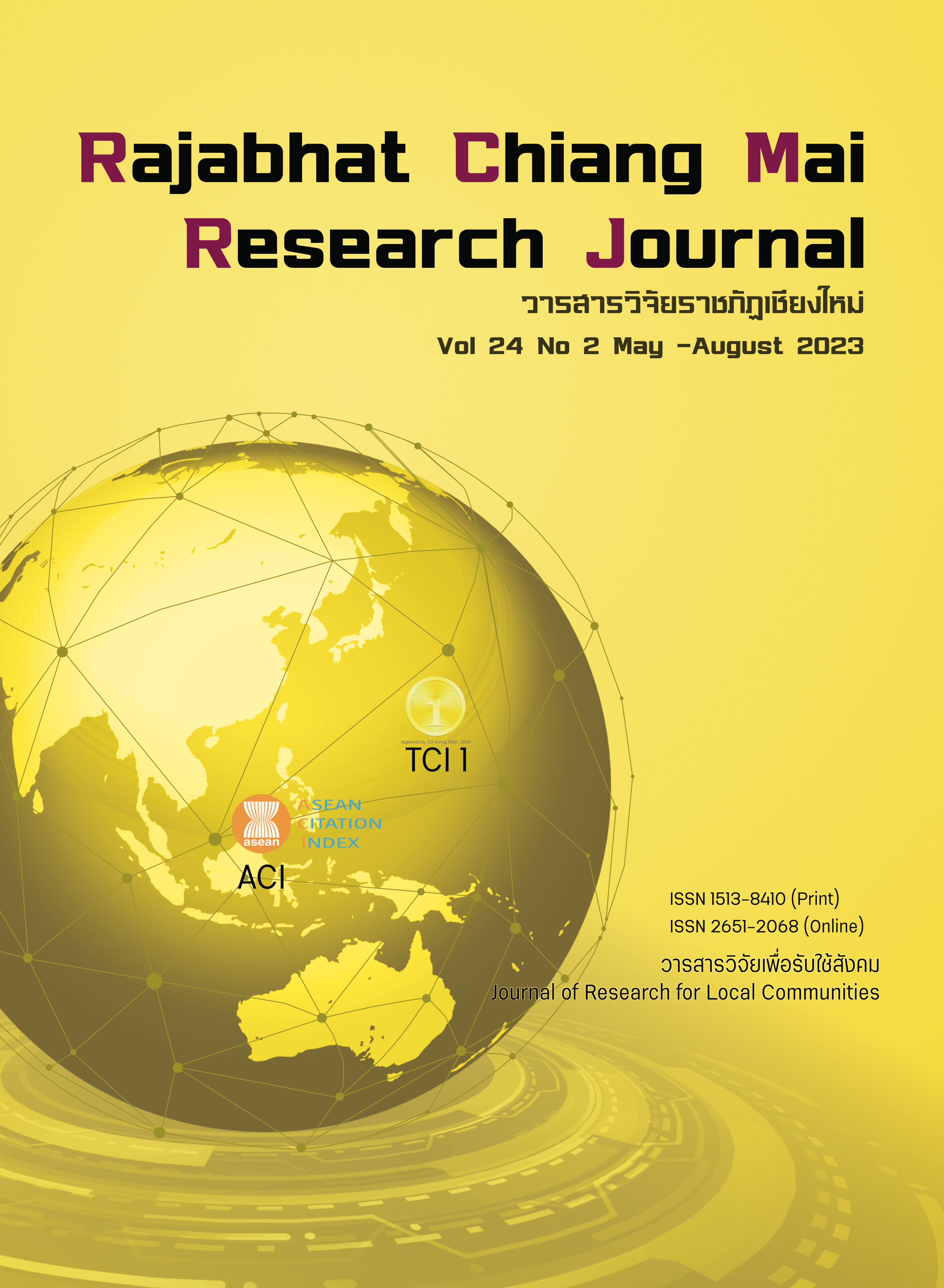The Study of Product Development from Sarong (Sinh) Fabric of San Kamphaeng, San Kamphaeng district, Chiang Mai Province
DOI:
https://doi.org/10.57260/rcmrj.2023.263141Keywords:
Sarong (sinh), Product development, Consumer acceptanceAbstract
Study and development of products from sarong (sinh) fabric of San Kamphaeng, San Kamphaeng Subdistrict, San Kamphaeng District, Chiang Mai Province has objectives: 1) to study the needs of entrepreneurs and target groups of Sarong (sinh) fabric of San Kamphaeng, 2) to develop product designs from sarong (sinh) fabric of San Kamphaeng, in conducting the research, the San Kamphaeng sarong fabric was used and applied to be bag products in various 3 types: handbag, shoulder bag and backpack by surveying the shape from experts’ opinions and Thai consumer group, tourists in the target area. The tools used in the research were Physical test result record form, Mechanical test result record form and evaluated products by experts and the consumer acceptance questionnaire data that were analysed from the assessment forms and questionnaires with descriptive statistics, including percentage, mean, and Standard Deviation.
The materials used to form the product structure were leather, steel, and bag making equipment to make the products were strong and more complete. When the products made from San Kamphaeng sarong were given to all 6 experts, they were evaluated that the developed San Kamphaeng sarong products with an overall average of 4.35 at a very satisfied level. Results from consumer group acceptance test evaluation, it was found that consumers accepted San Kamphaeng sarong fabric products which were the most accepted. In this regard, handbag products and shoulder bag products, the consumers accepted the same, with an overall average of 4.67 and backpack products with an overall average of 4.63.
Downloads
References
Buason, C. (2017). San Kamphaeng Sarong Cotton Fabric. Retrived from https://www.facebook.com/Buason.cnx/?locale=th_TH (In Thai)
Burapajatana, J. (2016). Applying patterns from Identity of Jok woven textiles of Mae Jam todesign of cultural textile products for home decoration. Veridian E-Journal,Silpakorn University (Humanities, Social Sciences and arts), 9(3), 1720-1738. https://he02.tci-thaijo.org/index.php/Veridian-E-Journal/article/view/61762/50886 (In Thai)
Chinachan, T. . (2022). A Product Development of Long Li Jok Textiles by Using Community’s Cultural Identities. The Journal of Social Communication Innovation, 10(1), 168–178. https://so06.tci-thaijo.org/index.php/jcosci/article/view/256577 (In Thai)
Jaidee, W., Naimoo, S., Panyakob, O., & Wannalo, W. (2021)The Product Development of Embroider Pattern Bag Ethnic Lahu, in Wawi Sub-District Mae Suai District Chiang Rai Province. Archives, 6(2), 101-112. https://so02.tci-thaijo.org/index.php/JAR_CRRU/article/view/260065/175002 (In Thai)
Inpakdee, C., Boonyanate , P., & Bidahok, P. (2022). The Development of Wicker Products from Gros Michel Banana Fibers with Natural Dyes for Promote Career Among the Elderly. Rajabhat Chiang Mai Research Journal, 23(3), 222–236. https://doi.org/10.57260/rcmrj.2022.253998 (In Thai)
Intarakerd, M., Namkamon, C., & Yuyong, W. (2018). Conservation and Inheritance of Phamai Madmee Cinteandang, Ban Huasaphan Community, Phutthaisong District, Buriram Province. Business Review Journal, 10(1), 141–154. https://so01.tci-thaijo.org/index.php/bahcuojs/article/view/145057 (In Thai)
Kitipattanawit, J. (2021). Study of grain patterns of wicker basketry Mae Rim and Sankampaeng fabrics for application in developing bags of vetiver according to Sufficiency Economy Philosophy. Art and Architecture Journal Naresuan University, 12(2), 126-138. https://so01.tci-thaijo.org/index.php/ajnu/article/view/148551 (In Thai)
Pengiam, B., & Kanahawong, U. (2018). The Study of Local Wisdom Usage in the Way of Life at Ban Nong Bo, Ubon Ratchathani’s Identity Silk Production, the Lukkeaw Silk with Ebony Dye. Academic Journal of Mahamakut Buddhist University Roi Et Campus, 8(2), 148–159. https://so01.tci-thaijo.org/index.php/AJMBU/article/view/229102 (In Thai)
Pinjurai, N., Koktong, T., Nitayaprapha, T., & Pomraksa, S. (2021). Design and development of woven fabrics with local wisdom according to identity Of Ban Sap Charoen community, Pang Makha subdistrict, Khanu Woralaksaburi district. Design Echo, 2(1), 34–47. https://so02.tci-thaijo.org/index.php/jdecho/article/view/248627 (In Thai)
Puangthian, T. (1993). Preliminary statistics and research. Bangkok: Odeon Store. (In Thai)
Sombat, K., & Mahavarakorn, S. (2022). Mae Chaem Woven Textile: Intangible Cultural Heritage and Knowledge Management toward Thai as a Foreign Language in Active Learning Concept . Rajabhat Chiang Mai Research Journal, 23(1), 37–53. https://doi.org/10.14456/rcmrj.2022.251807 (In Thai)
Sukasukont, p. (2022). Guideline for Development of Marketing Strategies for Local Products of the Elderly Group in SamutPrakan Provience. Rajabhat Chiang Mai Research Journal, 23(2), 174–189. https://doi.org/10.14456/rcmrj.2022.255746 (In Thai)
Downloads
Published
How to Cite
Issue
Section
License
Copyright (c) 2023 Rajabhat Chiang Mai Research Journal

This work is licensed under a Creative Commons Attribution-NonCommercial-NoDerivatives 4.0 International License.
1. Articles, information, content, images, etc published in the “Community and Social Development Journal” are copyrighted by the Community and Social Development Journal, Chiang Mai Rajabhat University. In order to properly distribute the articles through print and electronic media, the authors still hold the copyright for the published articles under the Creative Commons Attribution (CC BY) license, which allows the re-distribution of the articles in other sources. References must be made to the articles in the journal. The authors are responsible for requesting permission to reproduce copyrighted content from other sources.
2. The content of the articles appearing in the journal is the direct responsibility of the article authors. The editorial board of the journal does not necessarily agree with or share any responsibility.














